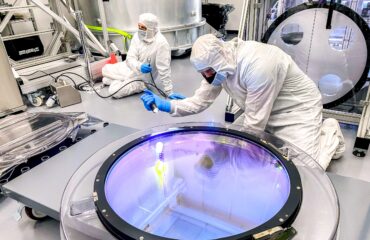
For how long will our species survive on Earth? Image generated using Ideogram AI.
By Mariana Meneses
Are we on the brink of redefining the very essence of our existence?
For centuries, humans have woven tales of immortality, seeking ways to transcend the limitations of time. But what if immortality is no longer confined to the realms of folklore and legend, and is becoming a scientific possibility?
Researchers have found that a molecule called cAMP plays an important role in regulating our body’s internal clock, also known as circadian rhythm. Circadian rhythms are cycles that last about 24 hours and control things like when we feel sleepy or awake. By understanding how these molecules work, scientists may be able to develop new ways to treat sleep disorders and other health problems caused by disruptions to our body’s clock.

Cyclic adenosine monophosphate (cAMP) is a small molecule that acts as a messenger inside cells, helping to transmit signals for various biological processes, while adenosine triphosphate (ATP) is a molecule that provides energy for cellular activities ( Wikipedia). Image: NEUROtiker.
This is just one of many new discoveries that may affect how we deal with time.
A recent breakthrough has gained widespread news coverage, as scientists at the University of Rochester have succeeded in increasing a mouse’s lifespan by transferring a longevity gene from naked mole rats, suggesting potential benefits for human health and longevity. Native to parts of Africa, naked mole rats are known for their exceptional resistance to age-related diseases and long lifespans, living up to ten times longer similarly-sized rodents.
The transferred gene is responsible for making a high molecular weight hyaluronic acid called HMW-HA, which when introduced to mice demonstrated potential anti-aging benefits. HMW-HA, which naked mole rats possess in far greater proportions than humans, has been linked to the rodents’ ability to resist cancer. If the gene proves transferrable to humans, it could hold promise for a significant reduction in cancers.
The World Health Organization reported that cancer caused ten million deaths in 2020, accounting for one in every six human deaths.

Naked Mole Rat. Image: Rawpixel Ltd.
The research was published in the journal Nature and was co-authored by Professor of Biology and Medicine Dr. Vera Gorbunova.
“It took us 10 years from the discovery of HMW-HA in the naked mole rat to showing that HMW-HA improves health in mice,” Dr Gorbunova said. “Our next goal is to transfer this benefit to humans.” This could occur either by increasing our bodies’ ability to synthesize HMW-HA, or by decreasing the chemical’s degradation in the body.
In 2013, Dr. Gorbunova and biologist Andrei Seluanov identified HMW-HA as the chemical that triggers cancer resistance in the naked mole rat, and in 2014 Dr. Gorbunova was award a $9.5 million grant by the National Institute on Aging for a five-year study on longevity.

Dr. Vera Gorbunova, Doris Johns Cherry Professor of Biology at the University of Rochester, is renowned for her pioneering research on longevity mechanisms, genome stability, and cancer resistance in exceptionally long-lived mammals, receiving numerous prestigious awards for her contributions. Image: The Gorbunova & Seluanov Laboratory
Extending human lifespan on Earth only makes sense as long as we keep the planet a habitable place, which will require greater efforts to combat climate change.
For instance, we know that coastal wetlands are at risk due to climate change, requiring immediate protection because they safeguard coastlines and wildlife. A new study warns that coastal wetlands are struggling to keep up with the pace of climate change. These ecosystems are important for protecting coastlines from storms and erosion, as well as providing habitat for wildlife. However, they are being threatened by rising sea levels and other results of climate change.
The study highlights the need for urgent action to protect these vital ecosystems.
The consequences of the modern human lifestyle extend beyond the planet. Another study analyzed samples of dust from the air filters of the International Space Station (ISS) and found higher levels of harmful chemical compounds than in homes in the United States and Europe, with potential sources being items brought on board by astronauts. The pioneering study was carried out by researchers from the University of Birmingham, in the United Kingdom, and from NASA’s Glenn Research Center, in the US.
The authors believe that the use of items brought on board by astronauts, such as cameras, MP3 players, tablets, medical devices and clothing, are potential sources of many of the harmful chemicals identified.
How are we using new technology to prolong our lifespan on Earth?
To NVIDIA CEO Jensen Huang, AI and accelerated computing will enable breakthroughs in climate science, but there are three “miracles” that need to happen. The first miracle required would be to simulate the climate fast enough and with a high enough resolution to predict climate outcomes with local granularity. The second is to emulate the physics of climate with high fidelity using AI. The third miracle needed is the ability to make massive data interactively accessible to policymakers, businesses, and scientists.
One important advance has been the development of an efficient electrochemical cell for capturing and releasing CO2 at room temperature, using less energy than traditional methods and offering promise for reducing climate change.
Capturing carbon dioxide (CO2) is an encouraging strategy for mitigating climate change. The new system, optimized with potassium and zinc ions, shows promise for industrial applications and is almost 95% efficient after multiple cycles. The method involves sequestering CO2 before it can enter the atmosphere, but it typically demands significant energy and infrastructure, while the new system functions at room temperature and therefore consumes less energy.
Another promising breakthrough comes from a team of plant and molecular biologists from the University of Kelaniya and the University of Peradeniya, both in Sri Lanka.
They found that many types of fungi that break down hardwood trees can also break down polyethylene, a common kind of plastic. Prior research has identified approximately 430 species of fungi and bacteria that are able to break down different kinds of plastic. In this new effort, they tested 21 species of hardwood-decaying fungi in their lab and found that all the types of fungi tested did indeed break down the plastic. They also found that more plastic decomposed in the absence of wood.
The findings may contribute to efforts to use fungi to process at least some of the massive amounts of plastic waste that are produced each year around the world.

We stand at the crossroads of innovation and environmental responsibility. Image generated using Ideogram AI.
Imagine a world where the boundaries of time blur, where the sands of our lifespan are not etched in stone but rather malleable to human ingenuity.
Could we extend humanity’s time on Earth, pushing the limits of longevity beyond what we’ve ever imagined? What if achieving longevity didn’t require the bite of a vampire or the elixir of a mythical fountain?
Our journey towards extending humanity’s lifespan on Earth is a complex endeavor. We find ourselves at the intersection of cutting-edge scientific breakthroughs and pressing environmental challenges. However, while the promise of longevity interventions may be tantalizing for many, it is tempered by the imperative to address climate change and protect our planet’s delicate ecosystems that, ultimately, make up the required conditions for our very existence.
Craving more information? Take a look at these recommended TQR articles:
- Reversing the Ageing Process? New Discovery Points to The Body’s Relationship With Time
- CRISPR Technology: Editing the Genetic Code, From Plants to Humans
- Life Is Defined by Biology, Not Physics
- Saving the Planet: Nobel Prize Recognizes Climate Science, but Will Mindsets Change in Time to Sustain Nature’s Potential and Value?
- The Clock is Ticking (Faster for the Vulnerable): Climate Action and Compensation Mechanisms After COP28
- Clean Technologies and Technologies That Clean: Undoing the Climate Damage We Have Caused
- Ecologist Urges Global Action and Sustainable Solutions to Safeguard the Amazon’s Ecosystem
- Preserving Biodiversity: The Race Against Ecosystem Loss
- Mega-trees: The Critical Role and Vulnerabilities of Nature’s Giants in Forest Ecosystems and Climate Change Mitigation



